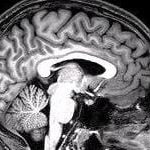1. In a cohort of about 80 adults who were born with very low birth weight (VLBW), total brain volume and gray matter volume were significantly decreased on magnetic resonance (MR) scans compared to same-sex siblings born at term.
2. 37.2% of included VLBW subjects had abnormal MR findings, and 15.4% exhibited periventricular leukomalacia (PVL) or PVL-like findings.
Evidence Rating Level: 2 (Good)
Study Rundown: Very premature birth and very low birth weight (VLBW) have been associated with various poor neurocognitive outcomes later in life, likely due in part to increased risk of ischemic damage in the neonatal period. This study aimed to quantify and characterize structural differences in adults with a history of VLBW by comparing their magnetic resonance (MR) scans to siblings born at term. 78 VLBW subjects and 72 paired same-sex siblings were included. 15.4% of VLBW subjects had periventricular leukomalacia (PVL) or PVL-like lesions. 37.2% of the VLBW group had any abnormal findings, including white matter lesions and cysts, compared to 12.5% of the sibling group. In a model adjusted for age, sex, and maternal factors, there was a statistically significant decrease in total brain volume of about 0.1 standard deviation (SD) in VLBW subjects compared to sibling controls. There was also a decrease in total gray matter, though not white matter, volume as well as cerebellar volume. Ventricle volume was greater in patients with VLBW. Within the VLBW group, adults who had been born small for gestational age showed further brain volume decreases compared to those who were appropriate for gestational age. This study controlled for several potential confounders affecting brain MR by comparing VLBW individuals to their own siblings. The results are consistent with past work that has found volumetric differences associated with VLBW and show a persistent effect into adulthood. However, the clinical significance of these differences remain unclear and require further study.
Click to read the study in Journal of Pediatrics
Relevant Reading: Management and outcomes of very low birth weight
In-Depth [case-control study]: Subjects born between 1978 and 1990 were recruited based on VLBW status, defined as less than 1500 g, from multiple tertiary centers in Finland. Patients with diagnosed motor and sensory disorders, including cerebral palsy, were excluded. Siblings with an age difference greater than 10 years were excluded. Images were reviewed for abnormalities by a blinded neuroradiologist, then T1-weighted images were analyzed for volume using automated software. 2.8% of the term sibling group had PVL or PVL-like lesions. A linear mixed model adjusting for sex, age, maternal smoking, maternal BMI, maternal age, primiparity, and total intracranial volume was used to assess volume differences between groups. On average, subjects with VLBW had smaller thalami, caudate nuclei, left putamen, left pallidum, and right hippocampus.
Image: PD
©2022 2 Minute Medicine, Inc. All rights reserved. No works may be reproduced without expressed written consent from 2 Minute Medicine, Inc. Inquire about licensing here. No article should be construed as medical advice and is not intended as such by the authors or by 2 Minute Medicine, Inc.


